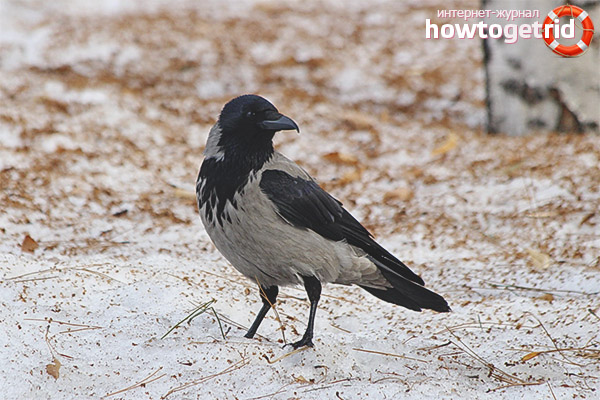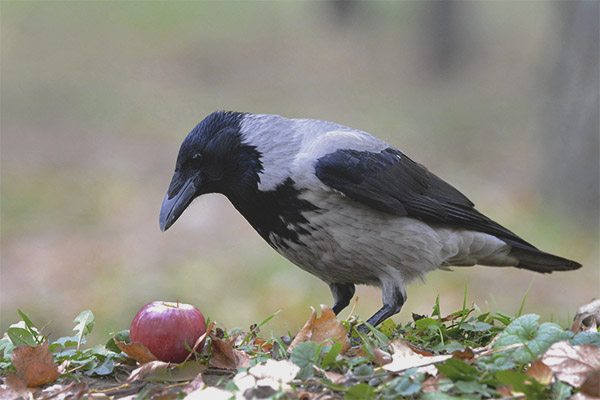The content of the article
Such a bird as the gray crow is the most common and recognizable species of birds. Note that this species of birds differs from its relatives by quick-wittedness, a lively mind, as well as the possibility of domestication and subsequent attachment to its owner.
Description of the species
The gray crow belongs to the family of corvids and is a fairly large bird, the body length is up to 51-53 cm, the maximum weight indicators reach 700 gr., The wingspan is up to 1 meter.
The characteristic coloring of the representatives of the species is gray (with the exception of the crown, tail, wings, and the front of the bird). The black-crowed beak of the crow is black - with a characteristic curved tip and prominent protuberance above the mandible. Legs of representatives of the species are black. The presence of gray in the color of the feather cover of the crow, in fact, is the main difference from other subspecies. Note that the young individuals have a darker color of plumage.The characteristic sounds made by the bird are the hoarse and loud Carr-Carrr.
According to the majority of ornithologists, the gray crow is a subspecies of the black crow, with the possibility of crossing representatives of both species. The way of life of the species practically does not differ - the birds are sedentary, as a rule, live in pairs or small groups (crow communities).
Power Features
As a rule, the food received by gray crows, living mainly in urban environments, is attributed to the roofs of houses, where they are saturated in a calm atmosphere.
Carrion crows are referred to predatory species of birds, as they are able to hunt small birds for their food, especially the bird ruins nests with newly emerged chicks.Also, the crow likes to eat some small animals and rodents. Often in urban park areas, gray crows hunt for squirrels. Large flocks of crows are capable of raids on hares, skillfully blocking the escape route of an escaping animal and driving it into a dead end. Often, these birds adopt the characteristic behavior of such a feathered as a skua, which is manifested by the terrorization of small gulls that hunt fish in the coastal zone.
Habitat

The greatest distribution of the gray crows has received throughout Eurasia. This bird can be found almost everywhere: in the conditions of the city, in the forests, in the territories of landfills and wastelands. Note that the crow does not scare people at all. Birds place their nests in any convenient habitat - not only on tall trees, but also on buildings. As a rule, for the night, representatives of this species of birds gather in fairly large groups or flocks. Often, cemeteries or park areas are chosen as a place to spend the night. Often, flocks and rooks join flocks of crows.
Breeding features
The breeding season of the crows begins with the onset of the first spring days. To attract females, males of this species perform complex figures in the air.
The gray crow nests in pairs, while the nests of representatives of the species are located in close proximity to each other.
Crows are considered to be very sensitive birds, this is especially pronounced in environmental issues. A pair of birds will never build their nest in a very polluted or smoky area. The crow can visit such ecologically unfavorable places only in search of food necessary for sustenance. That is, the nest is built on clean territory, which is explained by concern for future offspring.
Immediately the time at which the crows begin to build their nests - March-April. As a building material, birds use almost everything that they come across - from a variety of materials and rags to dry vegetation. The maximum amount of laying is 6 eggs, having a bluish tint with brown specks and fuzzy strokes. The female is engaged in incubation of the future offspring, the task of the crow is to provide the mother of the family with the necessary food.During the period of hatching of eggs, the bird often conducts its airing, which is expressed by its characteristic behavior - it becomes on its feet, lifting the body above the tray, after which it starts to sort out quickly for several tens of seconds.
The duration of the incubation period is about three weeks. Many observers have noticed that, as a rule, the male chick is the first to peck. After the birth of all the offspring, the female begins to help her partner in solving such tasks as the search for food both for her own food and for feeding the chicks.
The main condition for feeding adolescents is the availability of easily digestible and high-calorie food, for which reason for the feeding of their offspring crows often destroy the nests of other birds, taking their eggs to feed their chicks. Often for the same purpose, they steal nestlings of starlings or other small birds.
Habits of the species
Gray crows are rather mobile and active birds, who like to walk slowly from side to side.Also, this bird loves a variety of entertainment, for example, its favorite attractions are: planning in the air, swaying on wires, rolling on sloping roofs.
Also, these representatives of the species are very smart, for example, if they can not cope with the disclosure of any fruit, they simply rise to a great height, from where it is thrown off.
The gray raven, like any feathery, has its own worst enemy - it is such a bird as an owl. The latter attacks them at night when they sleep soundly.
Another feature of the crow is its excellent memory. Also gray crows can be called vindictive, for example, they can attack a dog that broke up a pack a few years ago. Sometimes birds take fur hats of people for their offenders, which is why there are cases when a bird flew at a person and began to fiercely peck at his headdress.
Schedule
Gray crows wake up before sunrise, gathering in small flocks on the roofs of houses or sitting on the branches of a large tree. As a rule, the first half of the day is occupied by the fact that the birds are in search of suitable food for feeding.Towards noon, the crows again gather in a flock in order to rest on a chosen large tree or more beautifully than the structure. After lunch, the birds again go in search of food. Before going to bed, they actively communicate, sharing their impressions of the past day.
Interesting Facts
- Such a species of birds, like the gray crows, living in conditions of bondage, is very attached to the person who brings up their feathered pet. Especially if a representative of this species got into the house to a man at a young age - by a chick.
- Most bird owners point out that ravens are very smart feathered birds, however, they have one significant drawback - the crows are not only smart, but thieving.
- Manual crow can live with a person for many years.
- Such a bird as a crow is, in fact, a professional handler. The peculiarity of the body of this species of birds is that a concentrated acid is formed in the bird's stomach, which does not allow infections to spread so that this bird does not eat. That is, it is one of the types of birds from which a person can not pick up any contagious disease.
- Crows often hide their prey, making it so that no one sees. If the crow noticed that someone had traced her, the prey is hiding in another place, while the bird will have to make sure that no one saw it.
- Crows are able to communicate with each other in their own language, which is extremely developed and, accordingly, has a rich stock of sounds to indicate various situations.
Video: gray crow (Corvus cornix)












To send